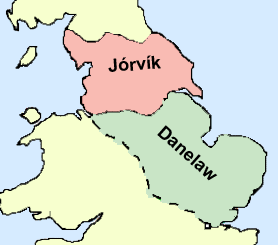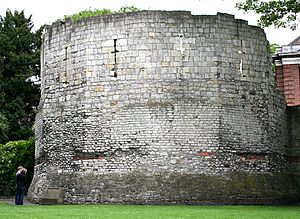Battle of York (867) facts for kids
Quick facts for kids Battle of York |
|||||||
|---|---|---|---|---|---|---|---|
| Part of the Viking invasions of England | |||||||
|
|||||||
| Belligerents | |||||||
| Great Heathen Army | Kingdom of Northumbria | ||||||
| Commanders and leaders | |||||||
| Ivar (possibly Ímar) Ubba |
Ælla of Northumbria † Osberht of Northumbria † |
||||||
The Battle of York was an important fight in England's history. It happened on March 21, 867, in the city of York. This battle was between the Vikings from the Great Heathen Army and the Anglo-Saxon Kingdom of Northumbria.
York was once a city controlled by the Roman Empire. After the Romans left, the Anglo-Saxons took over. York then became the capital city of the powerful Kingdom of Northumbria.
In 866, Northumbria was facing a big problem: a civil war. Two leaders, Ælla and Osberht, were both trying to be king. The Vikings, led by Ubba and Ivar, saw this as a chance. They arrived on the eastern shores of the British Isles and easily captured York.
In the spring of 867, Ælla and Osberht decided to work together. They wanted to force the Vikings out of York. The Northumbrians managed to get inside the city walls. However, the battle did not go well for them. Both Ælla and Osberht were killed.
After their victory, the Vikings put a new king in charge. This king, named Ecgberht, was a "puppet king." This means he ruled for the Vikings. Later, the Vikings created their own kingdom in York, called the Kingdom of Jórvík.
Contents
What Led to the Battle of York?
York: An Important City
The city of York was known as Eoferwic by the Anglo-Saxons. It became their capital after the Romans left in the 5th century. York was a very important place. It served both the king of Northumbria and the Archbishop of York.
The city still had its old Roman walls. However, by 867, these walls were old and falling apart. They did not offer much protection against attackers.
The Great Viking Invasion
Vikings had been raiding Britain since the 700s. But in the 860s, something changed. Large Viking armies were formed with the goal of conquering land, not just raiding.
In 865, the Great Heathen Army landed in East Anglia. This marked the start of a big invasion. It eventually led to the creation of the Danelaw, an area of England ruled by Vikings.
The Vikings, led by Ubba and Ivar, first took York on November 1, 866. Ivar's reason for attacking was said to be to get revenge for his father, Ragnar Lodbrok.
At this time, the Kingdom of Northumbria was in a civil war. King Osberht had been forced out by Ælla. Because of this fighting, the Vikings had little trouble taking York. However, they did not capture Ælla at that time.
The Battle of York: A Fierce Fight
In the spring of 867, Ælla and Osberht put their differences aside. They joined forces to try and push the Vikings out of Northumbria. This led to the Battle of York on March 21.
The battle started well for the Northumbrian army. They managed to break through the city's defenses. But then, the Vikings' fighting skills became clear. The narrow streets of York made it hard for the Northumbrians to use their larger numbers.
The battle ended with a defeat for the Northumbrian army. Both King Ælla and King Osberht were killed. Some stories say the Vikings caught the Northumbrians between their own forces and the city's defenders. But the Vikings fought back hard and won.
Norse stories say that Ivar and Ubba were brothers. They supposedly captured Ælla and performed a ritual called the "blood eagle" on him. However, the Anglo-Saxon Chronicle, a historical record, simply states that "both kings were slain on the spot."
What Happened After the Battle?

After their victory, the Viking leaders set up a new ruler in York. This was Ecgberht, a "puppet king." He ruled until 872, when a revolt forced him to leave.
Later, a Viking leader named Halfdan Ragnarsson ended the revolt in 876. He took direct control of York and the area around it. He divided the land among his followers. This led to the creation of the Kingdom of Jórvík. This Viking kingdom was centered in York.
The Kingdom of Jórvík was under Viking control until 910. Then, the Anglo-Saxons took it back. The Vikings reoccupied the kingdom several times until 954. After that, it became part of the Anglo-Saxon Kingdom of Wessex. No one tried to bring back the Kingdom of Northumbria after this.
Before the area became part of Wessex, the remaining Anglo-Saxon lords ruled the part of Northumbria north of the river Tees. Their base was in Bamburgh.


